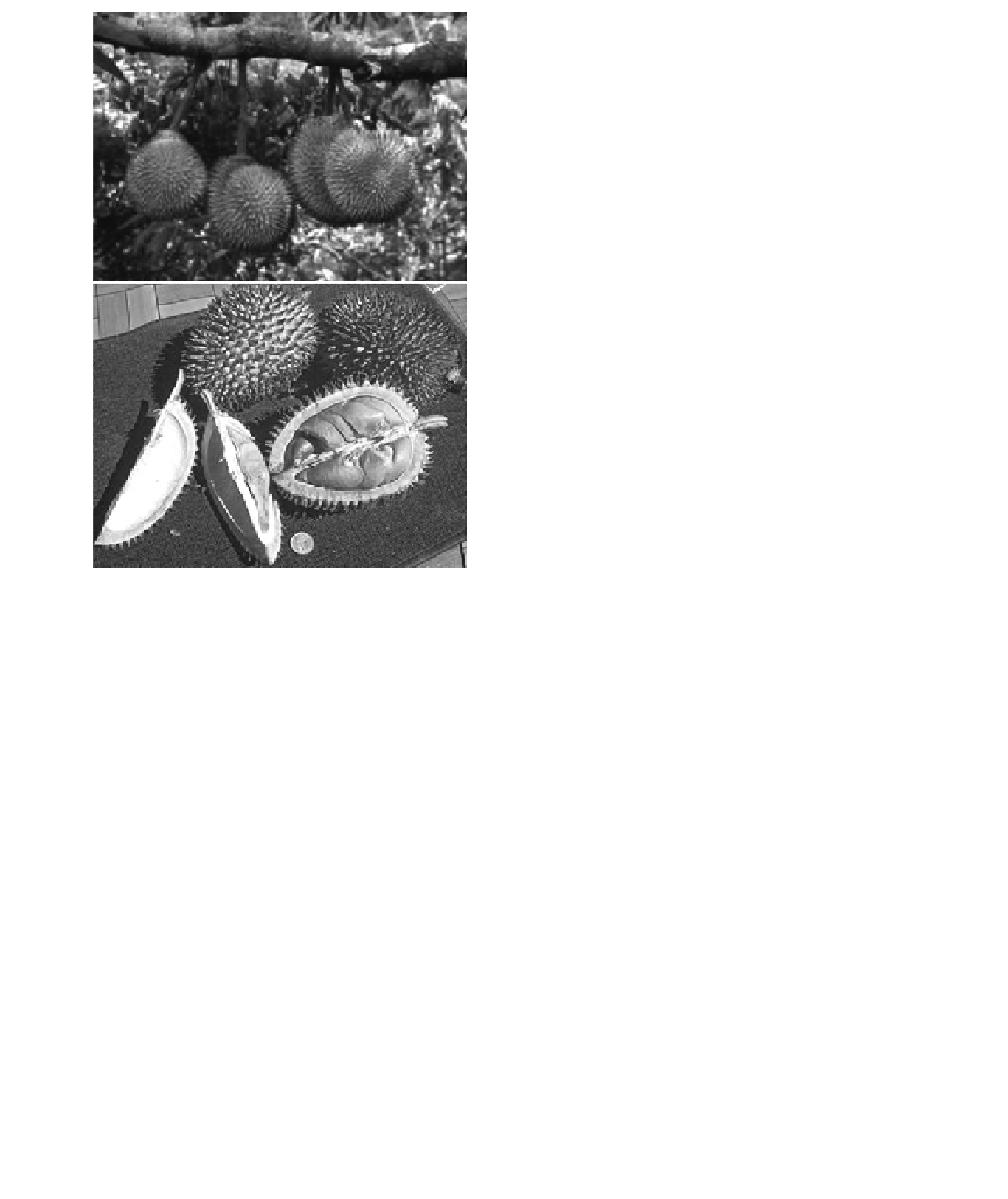Agriculture Reference
In-Depth Information
'Bakul,' 'Mas,' 'Sitebel,' 'Simanalagi,' and 'Simadat' are
being cultivated in Indonesia (Cunningham, 2000).
Paull and Ketsa (2004) reported that, at maturity, the
durian fruit falls naturally from the tree (with the fruit stem)
and then ripens in 2-4 days. For preventing natural fruit
fall (abscising), fruit may be tied to the limb or harvested
at maturity. Maturity is judged by appearance (fruit stalk
thickness and flexibility, abscission zone, or carpel sutures),
number of days from flowering, and a hollow sound when
tapped with a wood/rattan stick or knife (Paull and Ketsa,
2004). At the fully ripe stage, fruit normally splits into
segments of irregular width at the stylar end. Other changes
that occur at ripening before natural fruit splitting, include
an increase in soluble sugars, a decrease in starch, and
softening of the pulp. Other quality criteria include fruit
pulp with sweet flavor and a good texture, few or small
seeds, large aril percentage, and fruit weight of 1.5-3.5 kg
(3.3-7.7 lb), elongated to round shape, good shelf life, good
rind color and thickness, and freedom from disease and
insects (Paull and Ketsa, 2004).
Postharvest physiology and storage
The respiration rate of durian fruit is in the moderate to high
category (Paull and Duarte, 2011), ranging from 80 to 450
mg CO
2
/kg/hr at 22
◦
C (Paull and Ketsa, 2004). Brooncherm
and Siriphanich (1991) reported that the durian peel has a
much higher respiration rate and ethylene production than
the pulp. The ethylene production rate varies greatly with
almost no ethylene production in immature fruit; most of
the ethylene production is in the husk, with a very low rate
in the pulp (Siriphanich, 1996). The climacteric peak varies
in different varieties of durian fruit. Tongdee et al. (1987)
noted that the climacteric rise occurred first in the pulp
and that for 'Chanee' and 'Kan Yao,' the respiratory and
ethylene peaks level or decline when the fruit is overripe,
while in 'Mon Tong,' the peak occurs when overripe. Thai
consumers prefer to buy naturally ripened durians (with
light green or olive husk); fruit with a yellowish or brownish
husk are not regarded as fresh (Paull and Ketsa, 2004).
The optimum storage conditions for best shelf life
of durian fruit are 15
◦
C(59
◦
F) with RH of 85-95%
(Brooncherm and Siriphanich 1991). To avoid excessive
transpiration, fruit can be waxed or packaged in appropriate
moisture barrier film. Though low O
2
and high CO
2
reduce
respiration rate and ethylene production, the commercial
application of CA or MA has not been exploited for durian
fruit (Paull and Ketsa, 2004; Siriphanich, 1996). Chilling
injury may occur when durian is stored at a temperature
below 14
◦
C. Durian fruits are mainly kept in plastic
or
Figure 30.2.
Durian tree (top) and whole and cut
durian fruit (bottom).
In Vietnam, farmers successfully grow durian on water in-
undated delta soils through the use of extensive mounding
(Diczbalis and Westerhuis, 2005).
All durian varieties can be classified according to the
time from the bloom of flowers to harvest, size, quality,
and variation in seedlings. A lot of varieties of durian exist
in the world, but over 300 varieties of durian are present
in Thailand alone, out of which only few are in commer-
cial cultivation, while 100 different types of durian are
cultivated in Malaysia. In peninsular Malaya, there are 44
clones with small differences in time and extent of flow-
ering, floral and fruit morphology, productivity, and edible
quality (Brown, 1997). Malaysian varieties of durian in-
clude 'Dato Nina,' 'Durian Hijau,' 'Katoi,' 'Kop Kecil,'
'Batu,' 'Gombak,' 'Rim 2/Chanee,' 'Hew 3,' 'Tuan
Mek Hijau/Beserah,' 'Kan Yau/Tangkai-Panjang,' 'Mon
Thong/Bantal Mas,' 'Tok Litok,' 'MDUR78,' 'MDUR79,'
and 'MDUR88.' Among Thai varieties, 'Gaanyao,' 'Mon-
tong,' 'Kob Picul,' 'Chanee,' 'Luang, Kradoom Tong,'
and 'Chompoosri' are most prominent, while 'Sitokong,'
bamboo
baskets
(APO,
2006).
However,
recently,

Search WWH ::

Custom Search